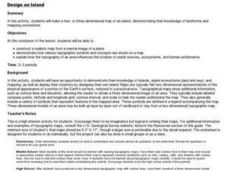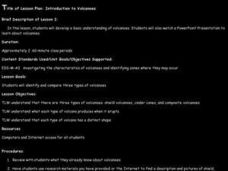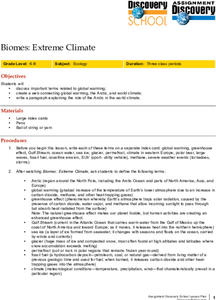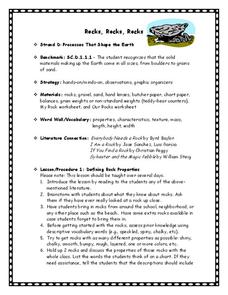Curated OER
Why is the Sky Blue?
Students explore diffusion or scattering of light. In this physics instructional activity, students explain why the sky is blue and sunsets/sunrises are red.
Curated OER
It looks Like Champagne
Students interpret phase diagrams and explain the meaning of vocabulary words. In this ocean explorer lesson students describe two uses of super-critical carbon dioxide.
Curated OER
Comets
Students explore the nature and composition of a comet. They research comet facts, legends, and myths. They identify different types of comets and describe what happens to a comet as it travels closer to the Sun.
Curated OER
Weather Predictions
Students record weather data and create a five day forecast. Students investigate the roles of meteorologists and identify symbols used on a weather map. After gathering weather data for a week, students will create a five day forecast...
Curated OER
The Water Cycle
Learners describe the water cycle. Students identify the processess in the water cycle. They draw an illustration of the water cycel with arrows showing the path water takes through the cycle. Learners label condesation, precipitation,...
Curated OER
Rocks, Minerals, and Fossils
Fourth graders do 5 different lab stations to explore rocks, minerals, and fossils.
Curated OER
Carving Mountains
Students explore geography by participating in an illustration activity. In this land-form lesson, students define vocabulary terms associated with glaciers and forests. Students utilize pens, cardboard and pottery clay to draw and...
Curated OER
Treetures
Students identify the different forests of the world and some of the characteristics that differentiate them. They explore old magazines, calendars and photos and fill out a scavenger hunt worksheet.
Curated OER
Corals and Coral Reefs
Students label the continents, oceans, and seas on a provided world map and use it to determine where they would expect most of the world's coral reefs to be found based on provided information the teacher has read to them.
Curated OER
Design an Island
Students make a map of an imaginary island using the topographic symbols provided from a worksheet. Students place lakes, dwellins, reefs, etc. in areas where they would logically be located from understanding how the topography of an...
Curated OER
Fossil Adventure
Students work as a class to write a general definition of fossil based on their discussion and examine pictures of the different types of fossils. Once discussion is complete, they write and illustrate a book about a T Rex that has died...
Curated OER
Geology Quiz Worksheet
In this geology quiz worksheet, learners answer 10 fill-in-the-blank questions about geology. They answer questions about types of rocks, hardness, and mineral attributes. They check their work with the answers at the bottom of the page.
Curated OER
The Water Cycle
Pupils develop a better understanding of the need to conserve our renewable resources. In this water cycle lesson students take notes, complete a guide sheet and illustrate the water cycle.
Curated OER
Geothermal Energy Crossword Puzzle
In this geothermal energy crossword puzzle worksheet, middle schoolers use the 17 clues to help them correctly complete the crossword puzzle.
Curated OER
A Hydrothermal Adventure
Students analyze hydrothermal vents. In this hydrothermal vents lesson, students discover the effects of hydrothermal vents on tectonic plates. Students make model hydrothermal vents to understand how they form and operate.
Curated OER
Rock Cycle
Fourth graders participate in a Rock Cycle game to gain an understanding of the cycles that form metamorphic, sedimentary and igneous rocks.
Curated OER
Relative Dating - Telling Time Using Fossils
Young scholars use fossil range charts to explain relative dating. They graph for ammonites, marine organisms that went extinct at the same time as dinosaurs.
Curated OER
Introduction to Volcanoes
Students develop a basic understanding of volcanoes. They watch a PowerPoint Presentation which introduces three types of volcanoes: shield volcanoes, cinder cones, and composite volcanoes.
Curated OER
Land Associations
Middle schoolers identify and explore life forms of various biomes, define transitional regions, examine effects of abiotic and biotic interactions, research a biome, and produce newspaper that features environmental information. Lessons...
Curated OER
Biomes: Extreme Climate
Students create a web connecting global warming, the Arctic, and wold climate. They write a paragraph explaining the role of the Arctic in world climate.
Curated OER
Hubble Space Telescope
High schoolers investigate the history and use of the Hubble Space Telescope. They take a quiz in order to establish in any prior knowledge. Students conduct research to find information in conjunction with participating in class...
Curated OER
Rocks, Rocks, Rocks
Young scholars are introduced to how the different types of rocks formed. As a class, they are read a book about rocks and create a list of what they already know about them. Using examples of rocks they find around the school, they...
Curated OER
Extreme Climate
Students discuss global warming, greenhouse effect, permafrost and other key words. In this climate lesson students create a web that connects global warming, the Arctic and world climate then write a paragraph explaining the role...
Curated OER
Dating Sedimentary Strata
Students investigate how the age of sedimentary strata is determined. In this sedimentary strata lesson plan, students work through problems that show that geological history covers millions of years. They distinguish between relative...























